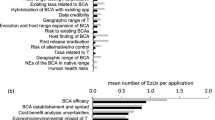Abstract
A model for assessing the unintended environmental risks of GM plants to other biological species is outlined. The model starts by allowing the local values and concerns in a country to frame the identification of endpoint entities and endpoints. It classifies biological diversity into ecological functional groups that are directly associated with the values and concerns. Multi-criteria decision analysis is used to identify the highest priority endpoint entities for further evaluation. For each of these entities, risk hypotheses are identified and prioritized to specify assessment endpoints. This is illustrated with Bt cotton in Vietnam, with particular reference to potential harms if Bt cotton adversely affected a natural enemy species. The possible harm can be evaluated using an equivalence test. A method for establishing equivalence limits for generalist natural enemies is described using pest management theory. These limits are likely to be large, which implies that large changes in natural enemy populations are necessary to cause significant harm, and that sample sizes may be quite manageable to evaluate equivalence statistically. The model emphasizes clear, expert-driven, ecologically based decision-making and provides formal methods for conducting an environmental risk assessment.



Similar content being viewed by others
References
Andow DA, Hilbeck A (2004) Science-based risk assessment for non-target effects of transgenic crops. BioSci 54:637–649
Andow DA, Klacan GC, Bach D, Leahy TC (1995) Limitations of Trichogramma nubilale (Hymenoptera, Trichogrammatidae) as an inundative biological control of Ostrinia nubilalis (Lepidoptera: Pyralidae). Environ Entomol 24:1352–1357
Andow DA, Hilbeck A, Nguyễn VT (2008) Environmental risk assessment of genetically modified organisms: challenges and opportunities with Bt cotton in Viet Nam. CABI, Wallingford
Andow DA, Lövei GL, Arpaia S (2009) Cry toxins and proteinase inhibitors in transgenic plants do have non-zero effects on natural enemies in the laboratory: Rebuttal to Shelton et al. 2009. Environ Entomol 38:1528–1532
Birch ANE, Wheatley RE, Anyango B et al (2004) Biodiversity and non-target impacts: a case study of Bt maize in Kenya. In: Hilbeck A, Andow DA (eds) Environmental risk assessment of genetically modified organisms. A case study of Bt maize in Kenya, vol 1. CABI, Wallingford, pp 117–186
Bode WM, Clavin D (1990) Yield-loss relationships and economic injury levels for European corn borer (Lepidoptera: Pyralidae) populations infesting Pennsylvania field corn. J Econ Entomol 83:1595–1603
Commission for Environmental Cooperation (CEC) (2004) Maize and biodiversity: the effects of transgenic maize in Mexico: key findings and recommendations. Commission for Environmental Cooperation, Montreal
Dodgson JS, Spackman M, Pearman A, Phillips LD (2009) Multi-criteria analysis: a manual. Department for Communities and Local Government. http://eprints.lse.ac.uk/12761/1/Multi-criteria_Analysis.pdf. Accessed 10 Nov 2010
Dutton A, Romeis J, Bigler F (2003) Assessing the risks of insect resistant transgenic plants on entomophagous arthropods: Bt-maize expressing CryAb as a case study. BioCont 48:611–636
Garcia-Alonso M, Jacobs E, Raybould A et al (2006) A tiered system for assessing the risk of genetically modified plants to non-target organisms. Environ Biosafe Res 5:57–65
Haughton AJ, Champion GT, Hawes C et al (2003) Invertebrate responses to the management of genetically modified herbicide-tolerant and conventional spring crops. II. Within-field epigeal and aerial arthropods. Phil Trans R Soc Lon Ser B 358:1863–1877
Hayes KR (2002) Identifying hazards in complex ecological systems. Part 1. Fault tree analysis for biological invasions. Biol Inv 4:235–249
Hayes KR, Gregg PC, Gupta VVSR et al (2004) Identifying hazards in complex ecological systems. Part 3. Hierarchical holographic model for herbicide tolerant oilseed rape. Environ Biosafe Res 3:109–128
Hilbeck A, Andow DA, Arpaia S et al (2006) Methodology to support non-target and biodiversity risk assessment. In: Hilbeck A, Andow DA, Fontes EMG (eds) Environmental risk assessment of genetically modified organisms. Methodologies for assessing Bt cotton in Brazil, vol 2. CABI, Wallingford, pp 108–132
Hilbeck A, Arpaia S, Birch ANE et al (2008) Non-target and biological diversity risk assessment. In: Andow DA, Hilbeck A, Nguyễn VT (eds) Environmental risk assessment of genetically modified organisms: challenges and opportunities with Bt cotton in Viet Nam. CABI, Wallingford, pp 115–137
Liu J, Chow S (1996) Comment: bioequivalence trials, intersection-union tests and equivalence confidence sets. Stat Sci 11:306–312
Lövei GL, Andow DA, Arpaia S (2009) Transgenic insecticidal crops and natural enemies: a detailed review of laboratory studies. Environ Entomol 38:293–306
Lu YH, Wu KM, Jiang YY et al (2010) Mirid bug outbreaks in multiple crops correlated with wide-scale adoption of Bt cotton in China. Science 328:1151–1154
Office of the Gene Technology Regulator (OGTR) (2005) Risk analysis framework. http://www.ogtr.gov.au/pubform/riskassessments.htm. Accessed 5 May 2007
Patterson S, Jones B (2005) Bioequivalence and statistics in clinical pharmacology. Chapman & Hall/CRC, Boca Raton
Prokrym DR, Andow DA, Ciborowski JA, Sreenivasam DD (1992) Suppression of Ostrinia nubilalis by Trichogramma nubilale in sweet corn. Entomol exp Appl 64:73–85
Romeis J, Bartsch D, Bigler F et al (2008) Assessment of risk of insect-resistant transgenic crops to nontarget arthropods. Nat Biotech 26:203–208
Suter GW II (2007) Ecological risk assessment, 2nd edn. CRC, Boca Raton
World Health Organization (WHO) (2000) The release of genetically modified organisms in the environment: is it a health hazard? http://www.euro.who.int/foodsafety/Otherissues/20020402_5. Accessed 19 Oct 2007
Acknowledgments
I thank Gabor Lövei and Claudia Zwahlen for discussions that led to my thoughts on generating equivalence limits.
Conflict of interest
The author D. A. Andow declares that the research was not sponsored and that he has no conflict of interest.
Author information
Authors and Affiliations
Corresponding author
Additional information
Conference Proceedings. “Decision Making and Science—The Balancing of Risk Based Decisions that Influence Sustainability of Agricultural Production”. 7th and 8th October 2010 in Berlin, Germany. Sponsored by the OECD Co-operative Research Programme.
Rights and permissions
About this article
Cite this article
Andow, D.A. Assessing unintended effects of GM plants on biological species. J. Verbr. Lebensm. 6 (Suppl 1), 119–124 (2011). https://doi.org/10.1007/s00003-011-0670-y
Published:
Issue Date:
DOI: https://doi.org/10.1007/s00003-011-0670-y




